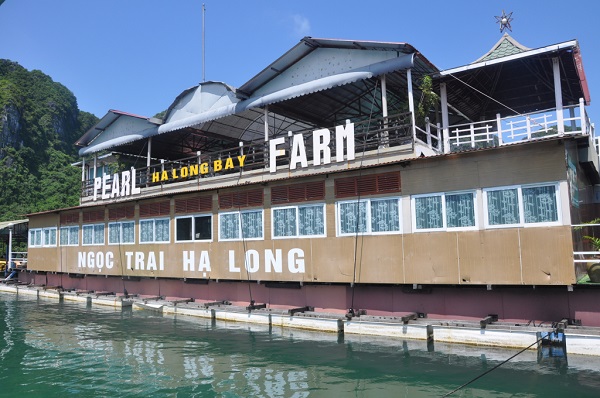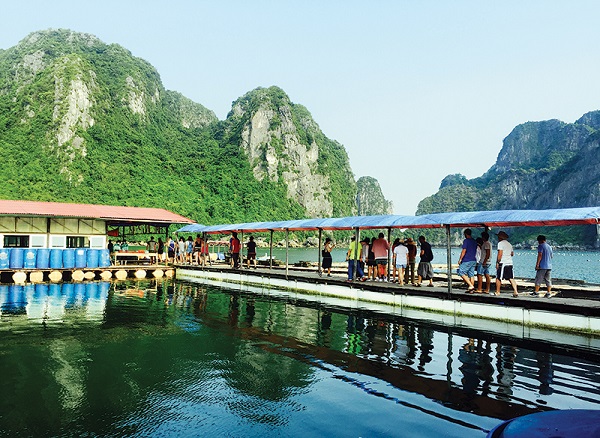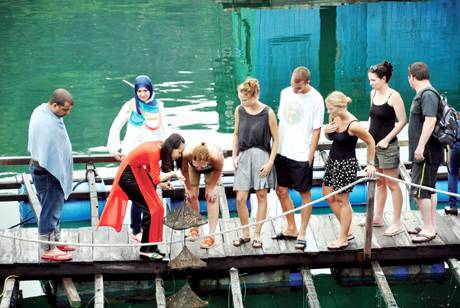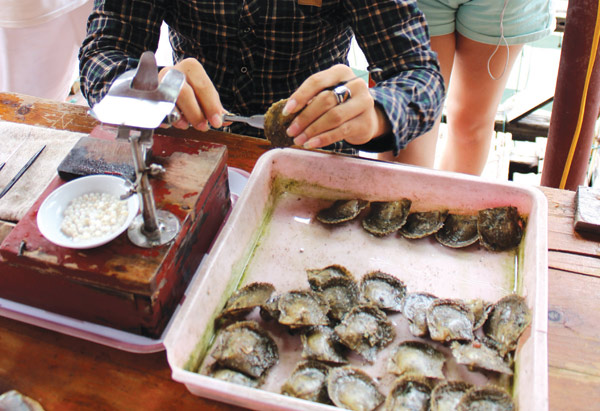Ha Long Bay Pearl Farm Village: A hidden gem amidst heritage
When mentioning Ha Long Bay, people often think of majestic limestone islands, mysterious caves and turquoise water. However, few people know that this place also owns another "pearl", hidden among the world's natural heritage, which is the pearl farm village.

History of Ha Long Bay pearl farm village
Although Ha Long Bay pearl village is still young compared to other traditional craft villages, it has a proud history of formation and development.
1995: A Japanese-owned pearl farm opened in Ha Long Bay, near Sung Sot Cave. This is an important milestone marking the beginning of the local pearl farming industry.
The farm grew: After the first years of effective operation, the farm was sold to new Vietnamese owners. Under new management, the farm continued to grow and achieve much success.
Ha Long Pearl Joint Stock Company: Currently, the pearl farm is owned by Ha Long Pearl Joint Stock Company. The company has been making efforts to bring the Ha Long pearl brand further in the international market.
Scale: Ha Long pearl farm has an area of 74 acres, including about 3,000 pearl cages. This place has a team of dedicated, experienced staff who always strive to bring visitors the best experience.
Culture process: When visiting the pearl village, visitors will have the opportunity to learn about the elaborate pearl culture process. Visitors will be able to see with their own eyes the pearls formed from tiny oysters, through the skillful hands of the craftsman, becoming splendid and precious pearls.
1995: A Japanese-owned pearl farm opened in Ha Long Bay, near Sung Sot Cave. This is an important milestone marking the beginning of the local pearl farming industry.
The farm grew: After the first years of effective operation, the farm was sold to new Vietnamese owners. Under new management, the farm continued to grow and achieve much success.
Ha Long Pearl Joint Stock Company: Currently, the pearl farm is owned by Ha Long Pearl Joint Stock Company. The company has been making efforts to bring the Ha Long pearl brand further in the international market.
Scale: Ha Long pearl farm has an area of 74 acres, including about 3,000 pearl cages. This place has a team of dedicated, experienced staff who always strive to bring visitors the best experience.
Culture process: When visiting the pearl village, visitors will have the opportunity to learn about the elaborate pearl culture process. Visitors will be able to see with their own eyes the pearls formed from tiny oysters, through the skillful hands of the craftsman, becoming splendid and precious pearls.
These types of pearls are farmed in Ha Long Bay
Saltwater pearls:
The type of pearl commonly farmed in Ha Long Bay is saltwater pearls. Compared to freshwater pearls, saltwater pearls have many outstanding advantages such as:
The type of pearl commonly farmed in Ha Long Bay is saltwater pearls. Compared to freshwater pearls, saltwater pearls have many outstanding advantages such as:
- High durability: Saltwater pearls can last longer outside the shell, with an average lifespan of up to hundreds of years. Meanwhile, freshwater pearls only have a lifespan of about 30 years.
- Thick nacre layer: Saltwater pearls have a thicker nacre layer, which helps create more shine and shine.
- Diverse colors: Saltwater pearls come in a variety of colors, from white, yellow, pink to black.
Pearl cultivation process:
Pearl farming is a complex process and requires meticulousness and care. Factors such as water depth, quality and salinity all affect pearl growth.
- Floating rafts: Visitors will be able to visit floating rafts where mussels are raised.
- Processing room: After harvesting, the mussels are taken to the processing room to remove the pearls from the shell.
- Gallery: Here, visitors can admire the pearls after being polished and perfected.
Culture time:
Normally, an oyster takes about 5 years to develop into a complete pearl. However, this time may vary depending on environmental conditions and culture techniques.
Interesting facts about pearls
Natural pearls are extremely rare:
In nature, the rate of mussels creating natural pearls is extremely low. For every 10,000 oysters, only 1 produces pearls. This makes natural pearls an extremely valuable gemstone.
Three main types of saltwater pearls:
Saltwater pearls are divided into three main types:
- Tahitian: This type of pearl has a characteristic black or blue color, cultured in French Tahiti.
- South Sea: This type of pearl is large in size and has a variety of colors such as white, yellow, and pink. South Sea is cultured in Australia, Indonesia and the Philippines.
Akoya: This type of pearl is small in size and ivory white in color. Akoya is cultured in Japan and China.
South Sea - The rarest type of pearl:
Compared to Tahitian and Akoya, South Sea pearls are considered the rarest. This is because the South Sea culture environment conditions are more demanding and the culture time is also longer.
The legendary pearl La Peregrina:
La Peregrina is one of the most famous pearls in the world. This pearl is the size of a large egg, ivory white in color and has a history of more than 500 years. The name La Peregrina in Spanish means "one of a kind", demonstrating the uniqueness and preciousness of this gem.
South Sea - The rarest type of pearl:
Compared to Tahitian and Akoya, South Sea pearls are considered the rarest. This is because the South Sea culture environment conditions are more demanding and the culture time is also longer.
The legendary pearl La Peregrina:
La Peregrina is one of the most famous pearls in the world. This pearl is the size of a large egg, ivory white in color and has a history of more than 500 years. The name La Peregrina in Spanish means "one of a kind", demonstrating the uniqueness and preciousness of this gem.

How to visit pearl village in Ha ong Bay
Tour selection:
- Most tourists visit Ha Long Bay pearl village on a cruise lasting at least 3 days.
- Travel companies often include entrance tickets to the pearl village in the tour package.
- If you want to explore on your own, you can rent a local rowing boat to travel to the pearl village.
- Negotiate the price before boarding the boat to avoid being ripped off.
- Entrance fees:
- Entrance fee to the pearl village is 30,000 VND (~$1.50 USD) per person.
- Note:
- You should bring sunscreen, hats and sunglasses because the weather in Ha Long Bay is quite hot.
- Bring cash to pay for admission tickets and other services.
- You should carefully ask about the price before buying any product at the pearl village.

The right time to visit Ha Long Bay pearl village
Weather:
Since the pearl farm is located in Bai Tu Long Bay, visitors should prepare carefully for different weather conditions.
Since the pearl farm is located in Bai Tu Long Bay, visitors should prepare carefully for different weather conditions.
- Summer (June - September): Hot and humid. Visitors should bring sunscreen, hats, sunglasses and cool clothes.
- Fall (October - December): Cool, mild. This is the ideal time to visit Ha Long Bay.
- Winter (January - March): Cold, possibly drizzle. Visitors should bring warm clothes, umbrellas and scarves.
- Spring (April - May): The weather is warm and pleasant.
- Note:
- he weather in Vietnam can change erratically, so tourists should regularly update the weather forecast before traveling.
- Tourists should bring mosquito repellant regardless of the season.

Wishing you a fun and memorable visit to Ha Long Bay pearl farm village!